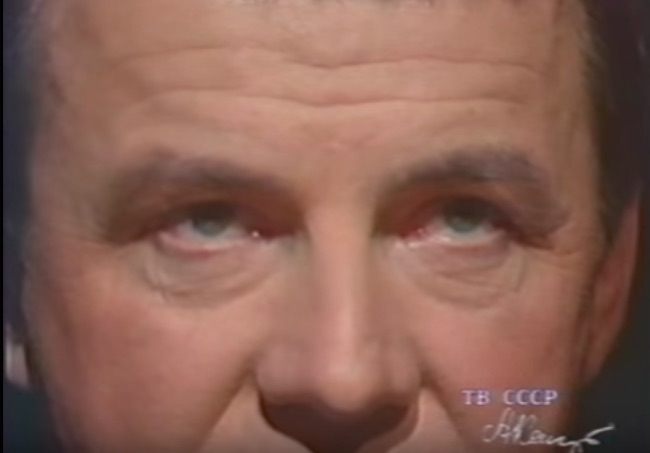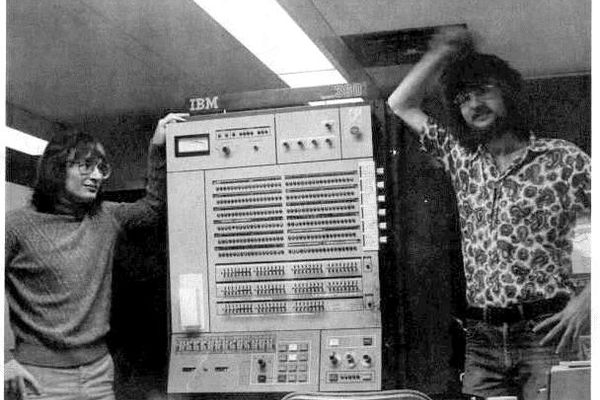A Psychic Healer Tried to Hypnotize Soviets to Distract From the Fall of Communism
Pay no attention to the man behind the Iron Curtain.

On October 9, 1989, broadcasts around the world were buzzing with news heralding the end of the Soviet Union. Protests had broken out in East Germany, and over the following weeks they crescendoed with the fall of the Berlin Wall. After the evening news on Soviet television ended that night, however, the screen showed a close-up of a man’s face. He spoke in soothing tones as he gazed through the camera into the eyes of the mass audience on the other side of the screen.
“Relax,” he told them. “Let your thoughts wander free.”
This was Anatoly Mikhailovich Kashpirovsky, who has been described as a faith healer, “perestroika’s chief magician,” and the spiritual heir to Rasputin. Over the course of a few weeks in 1989, he conducted six televised séances (as these sessions were called, though Kashpirovsky was reaching out to the minds of his live audience, rather than the spirits of the dead). They were broadcast across the Soviet Union, and he attempted, essentially, to hypnotize an entire country. Ostensibly, Kashpirovsky was there to remotely heal his audience of physical ills, but he was also serving as a distraction from the news filtering in from the outside and the clues that the Soviet Union was crumbling.
“It seemed the population was slowly waking up from a kind of trance,” writes media theorist Wladimir Velminski, of Bauhaus University Weimar, in his book Homo Sovieticus, released in translation earlier this year. “Kashpirovksy’s transmission represents the last effort of Soviet power to initiate the citizenry into the mysteries of the communist apparatus that was in the course of disappearing.” Kashpirovksy’s job, whether he knew it or not, was to keep the populace from freaking out about the end of their world.
Kashpirovsky was born in Ukraine in 1939, and he trained in clinical psychotherapy, which he practiced for 25 years. In 1987 he started practicing his craft on the country’s Olympic weightlifting team, which dominated the competition in the 1988 Summer Olympics, with six gold medals and two silvers. In Russia, there had been a long tradition of looking for ways to mold physical performance through psychological means—it’s one of the reasons that Michael Murphy, a founder of the vibey, spiritual retreat–focused Esalen Institute, started traveling to the Soviet Union in the 1970s, for instance. Murphy was interested psychic and transcendent experiences in sports, and people in the Soviet Union were more willing than Americans to entertain the power of psychic phenomena. As Murphy puts it, “You scratch a Russian, and you find a mystic.”
Kashpirovsky’s mental work with the weightlifting team brought him some renown, and in 1988 he became the head of the Republican Center of Psychotherapy in Kiev and started appearing on television. In these televised sessions, he attempted to demonstrate how the power of the mind can help people through physical trauma. In a series of televised séances, he attempted to stop millions of children from bedwetting, a feat he claimed to have accomplished. He also performed “remote psychological anaesthetization” on women undergoing surgery. Through the television, he talked to them during the procedure, and he claimed he was able to help them feel no pain.
In the fall of 1989 Kashpirovsky’s ministrations were broadcast to a much wider audience—across the Soviet Union and in Israel, Czechoslovakia, and Scandinavia. In the first of his six Channel One sessions, he asked everyone watching to have a container of water handy to absorb the healing vibrations Kashpirovsky was sending out.
“You can leave your eyes open for a while,” he said. “Have a look at your surroundings. There should be no pointed objects, and no fire. Your posture should be stable … Rid your mind of everything. Get rid of all those goals and ambitions. Everyone, close your eyes. No matter what emotional reaction you have, don’t suppress them. And you will have different kinds of emotional reaction.”
Like Kashpirovsky’s earlier work, these séances were meant to heal the ailments of the people watching (as long as they weren’t too serious—Kashpirovsky warned anyone with epilepsy to turn off the television). But why was he given this massive platform of 300 million viewers to begin with?

Observers and scholars of the falling Soviet state believe this attempt at mass hypnosis wasn’t about healing so much as distraction. The head of Soviet television at the time believed that the medium was primarily a salve for an anxious population, and as Bernice Glatzer Rosenthal writes in The Occult in Russian and Soviet Culture, “There are indications that the Communist Party officials who ran state television hoped that Kashpirovsky’s teleséances would serve as a ‘grand diversion,’ to distract people’s attention from the plummeting economy and need the talk of an imminent apocalypse or a new Time of Troubles.”
To some extent, it worked. “The streets would empty whenever Kashpirvosky came on,” one reporter told The Guardian. “Everything was taken at face value. So if state TV presented him as possessing these incredible powers, most people believed it.” In fact, he still maintains a following today and continues to give performances and speeches.
“Your silence is like a pause, a pause without words. Words don’t matter. They’re not involved in this,” Kashpirovsky told his audience. “It’s hard to understand, because all their lives people have been taught to try and understand. Forget everything … listen to the music … don’t be afraid of the process that’s starting within you.”
At the end of the broadcast, he told them to drink the water they had prepared earlier, and that it would help them continue to feel the effects of the work he’d done until the next broadcast. The state, Velminski writes, might have had ever higher hopes for its effects, that “drinking it would revive the unconscious of the land, which had fallen ill, and install the aims of communism in the popular mind yet again.”


















Follow us on Twitter to get the latest on the world's hidden wonders.
Like us on Facebook to get the latest on the world's hidden wonders.
Follow us on Twitter Like us on Facebook